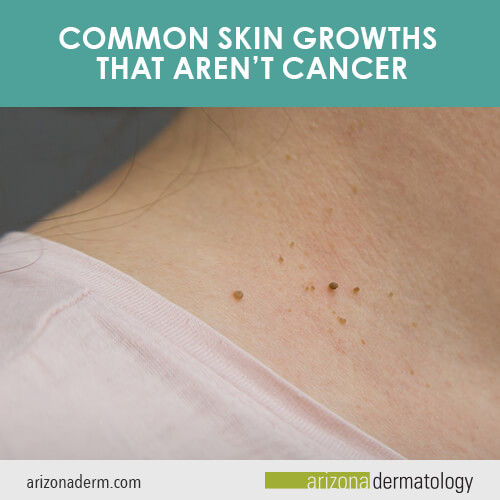 Something odd has cropped up on your skin. What is it? Should you worry?
Something odd has cropped up on your skin. What is it? Should you worry?
You should always have new skin growths checked out by a dermatologist, just in case. That said, many skin growths aren’t dangerous, although they may be unsightly. Today we’re going to take a closer look at some common, non-cancerous skin growths.
Skin Tags
Skin tags are small skin growths that look like a flap of tissue connected to a stalk. Usually about the size of a pebble, some can grow larger and more bothersome. Anyone can get skin tags, although they are more common in older adults who are obese or have diabetes.
Common areas for skin tags to develop are on the neck, eyelids, armpits, inner thighs, and torso. Skin tags usually don’t hurt unless they are irritated by clothing or jewelry.
Skin tags aren’t dangerous and don’t need to be treated, but if they bother you, we can easily remove them during an office visit with cryotherapy. A quick application of liquid nitrogen destroys the skin tag. You may feel a slight pinching sensation. Skin tags can also be removed surgically, by electrocautery (burning), or by cutting off their blood supply so that they fall off on their own. Removed skin tags don’t grow back, but if you’re prone to them, you may develop more in the same area.
Cherry angiomas
A cherry angioma is a non-cancerous skin growth made up of blood vessels. As its name suggests, it is “cherry” red in color, and can occur anywhere on the body, although they are often found on the trunk. Cherry angiomas can be the size of a pinhead or up to a quarter inch in diameter. They may be smooth or raised.
Because they are made up of blood vessels, cherry angiomas may bleed if injured. They aren’t dangerous and don’t need to be treated, but some people choose to have them removed for cosmetic reasons. Cherry angiomas can be treated with cryotherapy, electrocautery, laser, or shave excision (where the cherry angioma is shaved off with a blade).
Seborrheic Keratosis
Seborrheic keratoses are non-cancerous skin growths that usually occur on the back, chest, neck, or face. They are more common in adults over the age of 50. Seborrheic keratoses appear waxy and are usually black, brown or light tan in color. Typically small, they may grow as large as an inch in diameter. While anyone can develop them, they tend to run in families.
Seborrheic keratoses are harmless and not contagious. They don’t need to be treated, but many people will choose to have them removed because they don’t like the way they look or because they become irritated or bleed when rubbing against clothing.
Seborrheic keratoses can be removed by freezing them, scraping them, or burning them off with electrocautery. If you are prone to them, you are likely to develop additional seborrheic keratoses in the future.
Lentigo
A lentigo (plural: lentigines) is a flat, dark spot on the skin, sometimes referred to as an “age spot” or “liver spot.” Lentigines are more common in older people with lighter skin, but can occur in anyone. Lentigines are typically caused by U.V. damage, but they can also form as a result of radiation treatment or some rare, inherited syndromes. While lentigines are not cancerous, they can look very much like skin cancer and should be seen by a dermatologist to make sure they aren’t melanomas.
There is no medical need to treat lentigines, but if you don’t like the way they look, we have treatments to help lessen their appearance. Bleaching creams, chemical peels, and skin resurfacing can help. Cryotherapy, laser or IPL therapy can destroy the melanocytes (pigment cells) and cause lentigines to fade. You can help avoid getting new lentigines by protecting your skin from sun exposure and avoiding tanning beds.
Dermatofibroma
A dermatofibroma is a small, hard lump commonly found on the arms and legs. They vary in color from pink to red or brown and may be itchy or tender. Dermatofibromas usually develop in response to a minor skin injury, such as an insect bite. Because a dermatofibroma can look like cancer, it’s important to have it checked out by a dermatologist.
Removing a dermatofibroma may cause scarring, which is why your doctor may recommend to leave it alone if it’s not causing symptoms. If you do choose to have it removed, a dermatofibroma can be treated with cryotherapy or surgical excision.
The best way to ensure any new skin growths aren’t cancerous is to have a skin check. Dermatologists are experts in the skin and will be able to ease any concerns you have about changes to your skin, or get you quick, effective treatment if it is needed.


